Battle of Otterburn
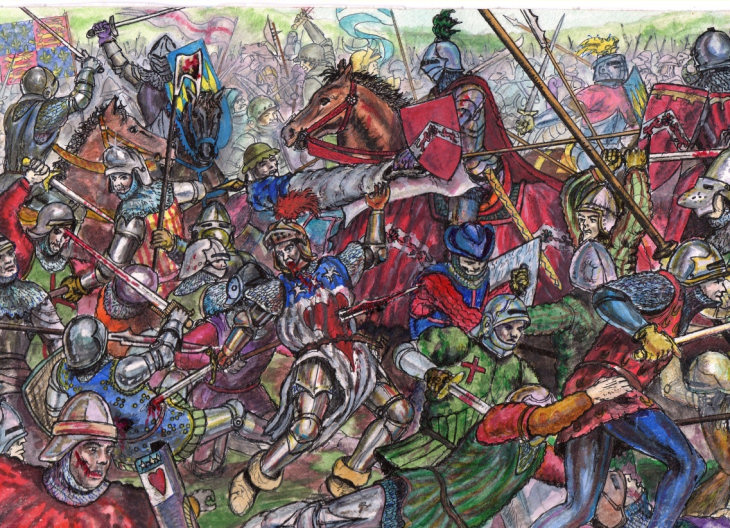
Reconstruction by Andrew Spratt
The
Battle of Otterburn took place on the 5 August 1388, as part of
the continuing border skirmishes between the Scottish and
English.
There are varying accounts of a battle that took
place in 1388. One version is that of a large hunting party upon
a parcel of hunting land (or chase) in the Cheviot Hills, hence
the term, Chevy Chase. The hunt is led by Percy, the English
Earl of Northumberland. The Scottish Earl of Douglas had
forbidden this hunt, and interprets it as an invasion of
Scotland. In response he attacks, causing a bloody battle which
only 110 people survived.
The best remaining record of
the battle is from Jean Froissart's Chronicles in which he
claims to have interviewed veterans from both sides of the
battle. His account is still regarded with some concern as
details, such as the distance between Newcastle upon Tyne and
Otterburn, are incorrect.
The Scottish James Douglas, 2nd
Earl of Douglas decided to lead a raid—one of a continuing
series on both sides of the border—into English territory. It
was timed to take advantage of divisions on the English side
between Lord Neville and Henry Percy, 1st Earl of Northumberland
who had just taken over defence of the border.
The Scots
divided their forces with the main force and their baggage train
heading towards Carlisle while a raiding party including Earl
Douglas ravaged the countryside around Durham and Newcastle.
Henry Percy sent his two sons Henry "Hotspur" Percy and Ralph to
engage while he stayed at Alnwick to cut off the marauders'
retreat.
Froissart says that the first fighting included
a meeting of the Earl Douglas and Henry Percy in hand to hand
combat, in which Percy's pennon was captured. Douglas then moved
off destroying the castle at Ponteland and besieging Otterburn
castle. Percy attacked Douglas' encampment with a surprise
attack in the late afternoon but first encountered the Earl's
serving men, giving the bulk of the forces time to muster and
attack them on their flank.
During the battle on a
moon-lit night Douglas was killed and the Percys were both
captured, with the remaining English force retreating to
Newcastle. Despite Percy's force having an estimated three to
one advantage over the Scots Froissart records 1040 English were
captured and 1860 killed whereas 200 Scots were captured and 100
were killed. The Westminister Chronicle gives a more reliable
estimate of Scottish casualties as being around 500 or so. When
the Bishop of Durham advanced from Newcastle with 10,000 men he
was so impressed by the ordered appearance of the Scottish
force, the din they set up with their horns, and their seemingly
unassailable position, that he declined to attack.
Such a
decisive victory kept the two sides apart for some time. In 1402
the Earl Douglas' cousin attempted to emulate his great victory
and hopefully survive but the Battle of Humbleton Hill was
almost an exact reverse of Otterburn and a great defeat for the
Scots.
Of such renown was the battle of Otterburn that
several ballads were composed in its honour including The Battle
of Otterburn and The Ballad of Chevy Chase (Child ballads 161
and 162). Chevy Chase rather mangles the history of the battle
and may be confusing other conflicts at around the same time but
it is still cited as one of the best of the ancient ballads.
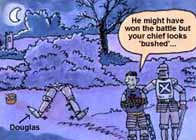 |
_Percy,_Battle_of_Otterburn_small.jpg) |
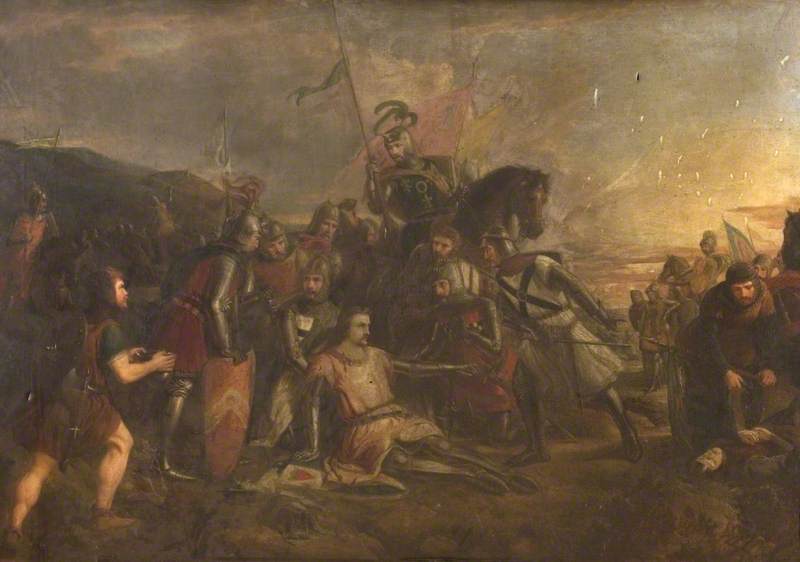 |
|
The battle of Otterburn: won by a dead man |
Percy's pennon - click to enlarge |
The Death of Douglas and Capture of Sir Ralph
Percy by Sir John Maxwell
Painted by by Samuel West; held in
the Burrell Collection, Glasgow. |
 |
| Pennant of James, 2nd Earl of Douglas |
 |
| The Earl at Otterburn - Cigarette
card |
 |
| Skirmish line at the battle of
Otterburn - S. Walsh (Above) |
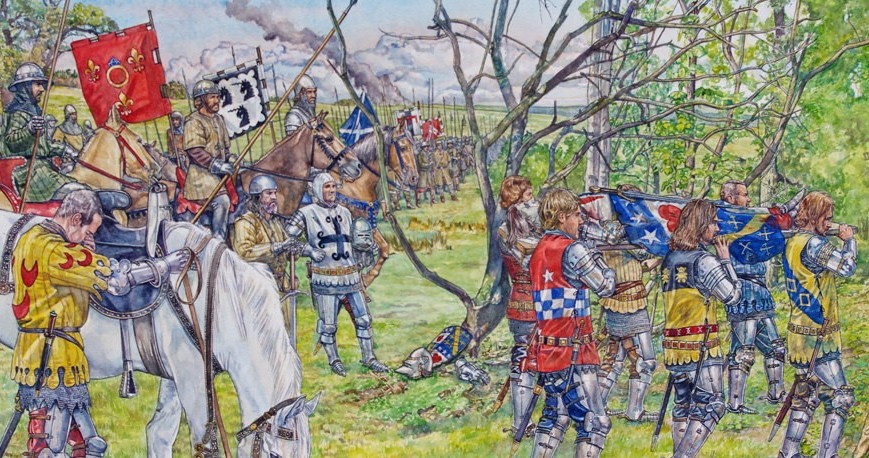 |
| The Earl of Douglas's body being
removed from the battlefield - S. Walsh (Above) |
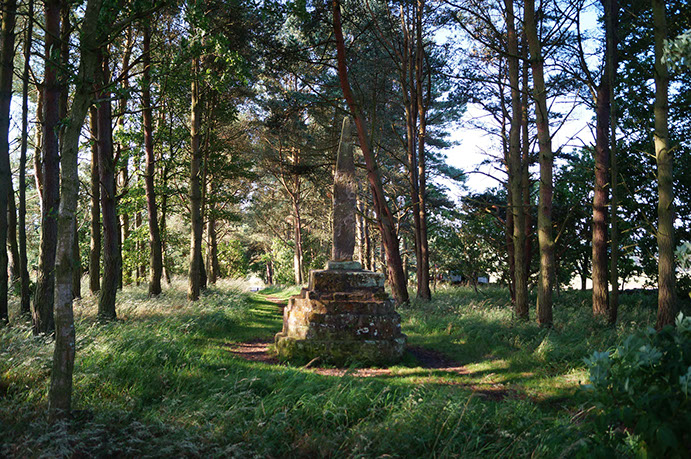 |
Percy's Cross, in the woods of
Otterburn
The morning after the battle, the site where Sir James Douglas,
Earl of Douglas had been slain was marked with a standing stone.
This remained in place until 1777 when Hugh Percy, Duke of
Northumberland expressed an interest in building a monument to
the battle concurrent with construction of the Turnpike Road.
The relevant landowner however didn’t trust the Duke but agreed
to do the work himself and removed the battle stone to form the
foundations of the new monument. This he erected closer to the
road so it could be visible to passers-by and reduce any
interference from the Duke. |
The battle continued by moonlight and the Scottish leader,
the
2nd Earl Douglas, was mortally wounded. He was worried that
his death would encourage the English, so he told his men to
hide his body beneath a bush so nobody could see it.
The
battle of Otterburn: won by a dead man When Percy offered to
capitulate, he was directed surrender to the bush under which
Douglas was lying and so the battle became famous because it was
won by a dead man.
See also:
• The Otterburn
video
• Southdean
Church - where the planning meeting was held

Location:
Northumberland. W of village & n of A696 or s of village nr Elsdon at
Battle Hill
Amongst the trees at the side of the A999, just beyond Otterburn is the
Douglas Cross which is believed to be the spot where Percy was killed.
There is
parking there and information boards relating to the Battle.
The battle
stone is 150 metres east of Percy's Cross
See also:
•
Map of the
battlefield
Any contributions will be
gratefully accepted
Errors and Omissions
|
|
The Forum
|
|
What's new?
|
|
We are looking for your help to improve the accuracy of The Douglas
Archives.
If you spot errors, or omissions, then
please do let us know
Contributions
Many articles are stubs which would benefit from re-writing.
Can you help?
Copyright
You are not authorized to add this page or any images from this page
to Ancestry.com (or its subsidiaries) or other fee-paying sites
without our express permission and then, if given, only by including
our copyright and a URL link to the web site.
|
|
If you have met a brick wall
with your research, then posting a notice in the Douglas Archives
Forum may be the answer. Or, it may help you find the answer!
You may also be able to help others answer their queries.
Visit the
Douglas Archives Forum.
2 Minute Survey
To provide feedback on the website, please take a couple of
minutes to complete our
survey.
|
|
We try to keep everyone up to date with new entries, via our
What's New section on the
home page.
We also use
the Community
Network to keep researchers abreast of developments in the
Douglas Archives.
Help with costs
Maintaining the three sections of the site has its costs. Any
contribution the defray them is very welcome
Donate
Newsletter
If you would like to receive a very occasional newsletter -
Sign up!
Temporarily withdrawn.
|
|
|
|
|
|
|
|


